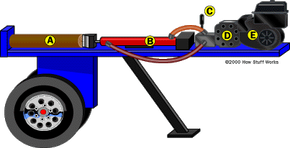How Log Splitters Work

The simplest hydraulic device that you find in common use today is thelog splitter. It contains all of the basic components of a hydraulic machine:
- Anengine, normally a smallfour-stroke gasoline engine, provides the power for the system. The engine is attached to a hydraulic oil pump.
- Thehydraulic oil pumpcreates a stream of high-pressure oil, which runs to a valve.
- Thevalvelets the operator actuate thehydraulic cylinderto split a log.
- There is also atankto hold the hydraulic oil that feeds the pump and usually afilterto keep the oil clean.
Valves can apply both forward and backward pressure to the piston. One type of valve is a "spool valve" because of its resemblance to a spool from a spool of thread.
Advertisement
Let's look at some of the specifics of these components to see how a real hydraulic system works. If you take a trip down to your local building supply center or a place likeNorthern Tool and Equipmentand look at the log splitters, you will find that a typical backyard log splitter has:
- A 5-horsepower gasoline engine
- A two-stage hydraulic oil pump rated at a maximum of 11 gallons per minute (3 gpm at 2,500 psi)
- A 4-inch-diameter, 24-inch-long hydraulic cylinder
- A rated splitting force of 20 tons
- A 3.5-gallon hydraulic oil tank
Atwo-stage pumpis an ingenious time-saver. The pump actually contains two pumping sections and an internal pressure-sensing valve that cuts over between the two. One section of the pump generates the maximum gpm flow rate at a lower pressure. It is used, for example, to draw the piston back out of a log after the log has been split. Drawing the piston back into the cylinder takes very little force and you want it to happen quickly, so you want the highest possible flow rate at low pressure. When pushing the piston into a log, however, you want the highest possible pressure in order to generate the maximum splitting force. The flow rate isn't a big concern, so the pump switches to its "high pressure, lower volume" stage to split the log.
We'll look at hydraulic pumps in the next section.

